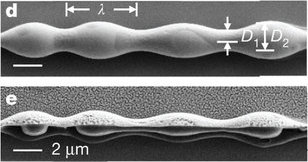Xiangdong Liang Research Scientist I am currently a reserach scientist at Aramco Boston Research Center. I am interested in physics-based mathematical modeling and high-performance numerical computation. I obtained my Ph.D in Applied Mathematics from MIT, under the supervision of Prof. Steven Johnson. Before coming to MIT, I studied at City University of Hong Kong, under the supervision of Prof. Roderick Wong. |
 |
Publications
| [1] | Z. Lin, X. Liang, M. Lončar, S. G. Johnson, and A. W. Rodriguez. Cavity-enhanced second-harmonic generation via nonlinear-overlap optimization. Optica, 3(3):233+, March 2016. [ bib | DOI | http | .pdf ] |
| [2] | X. Liang. Modeling of fluids and waves with analytics and numerics. Ph.D. Thesis. [ .pdf ] |
| [3] | X. Liang and S. G. Johnson. Formulation for scalable optimization of microcavities via the frequency-averaged local density of states. Optics Express, 21(25):30812+, December 2013. [ bib | DOI | http | .pdf ] |
| [4] | J. J. Kaufman, R. Ottman, G. Tao, S. Shabahang, E-H Banaei, X. Liang, S. G. Johnson, Y. Fink, R. Chakrabarti, and A. F. Abouraddy. In-fiber production of polymeric particles for biosensing and encapsulation. Proceedings of the National Academy of Sciences, 110(39):15549–15554, September 2013. [ bib | DOI | http | .pdf ] |
| [5] | B. Zhen, S.-L. Chua, J. Lee, A. W. Rodriguez, X. Liang, S. G. Johnson, J. D. Joannopoulos, M. Soljačić, and O. Shapira. Enabling enhanced emission and low-threshold lasing of organic molecules using special Fano resonances of macroscopic photonic crystals. Proceedings of the National Academy of Sciences, 110(34):13711–13716, August 2013. [ bib | DOI | http | .pdf] |
| [6] | A. Gumennik, L. Wei, G. Lestoquoy, A. M. Stolyarov, X. Jia, P. H. Rekemeyer, M. J. Smith, X. Liang, B. Grena, S. G. Johnson, S. Gradečak, A. F. Abouraddy, J. D. Joannopoulos, and Y. Fink. Silicon-in-silica spheres via axial thermal gradient in-fibre capillary instabilities. Nature Communications, 4, July 2013. [ bib | DOI | http | .pdf ] |
| [7] | J. J. Kaufman, G. Tao, S. Shabahang, E-H Banaei, D. S. Deng, X. Liang, S. G. Johnson, Y. Fink, and A. F. Abouraddy. Structured spheres generated by an in-fibre fluid instability. Nature, 487(7408):463–467, July 2012. [ bib | DOI | http | .pdf ] |
| [8] | D. S. Deng, J. C. Nave, X. Liang, S. G. Johnson, and Y. Fink. Exploration of in-fiber nanostructures from capillary instability. Optics Express, 19(17):16273+, August 2011. [ bib | DOI | http | .pdf ] |
| [9] | X. Liang, D. S. Deng, J. C. Nave, and S. G. Johnson. Linear stability analysis of capillary instabilities for concentric cylindrical shells. Journal of Fluid Mechanics, 683:235–262, 2011. [ bib | DOI | http | .pdf | |
| [10] | X. Liang and R. Wong. On a Nested Boundary-Layer Problem. Communications on Pure and Applied Analysis, 8(1):419–433, January 2009. [ bib | DOI | http | .pdf ] |
Research
Project I: Capillary Instability of Concentric Cylindrical Shells
Keywords: Computational Fluid Dynamics, Level-Set Methods, Capillary Instability, Linear Stability Analysis
Computational Tools: C, MATLAB, MEX, OpenMP, FFTW, Lapack.
A classic example of capillary instability (Plateau-Rayleigh instability) is the breakup of a fluid thread into droplets due to surface tension force. Motivated by complex multi-fluid geometries currently being explored in fibre-device manufacturing, we theoretically and computationally studied capillary instabilities in concentric cylindrical flows of N fluids with arbitrary viscosities, thicknesses, densities, and surface tensions in both the Stokes regime and for the full Navier-Stokes problem.
The mathematical model we built can quickly predict the breakup length-scale and time-scale of concentric cylindrical fluids, and provides useful guidance for material selections in fiber-drawing experiments. For example, in our experimental collaborators' recent work published in Nature, they developed a technique to produce uniform sized, structured core-shell particles by capillary instability, and our model captured the main physics in this experiment and predicted correct length-scale of these spherical particles.
In addition to the theoretically linear stability analysis, we also implemented a full 3D Stokes simulation by spectral and level-set methods to understand the physics from a computational perspective. One interesting example is to predict which interface (inner or outer) breaks up first in a three-fluid system. For various surface tensions of the outer interface γ2, the following simulation movies confirmed the prediction from the mathematical analysis that the inner interface breaks up first when γ2=6 (figure a), the outer interface breaks up first for γ2=25 (figure c), and near-simultaneous breakup occurs for γ2=15 (figure b).
Project II: Large-Scale Microcavity Topology Optimization
Keywords: Computational Electromagnetism, Parallel Computing, Nonlinear PDE-Constrained Optimization
Computational Tools: C, PETSc, MPI, NLOPT, PaStiX, Mumps.
Applications such as lasers and nonlinear devices require optical microcavities with long lifetimes Q and small modal volumes V. We formulate and solve a full 3d optimization scheme, over all possible 2d-lithography patterns in a thin dielectric film. The key to our formulation is a frequency-averaged local density of states (LDOS), where the frequency averaging corresponds to the desired bandwidth, evaluated by a novel technique: solving a single scattering problem at a complex frequency. To compute the objective LDOS, we implement a full 3D Maxwell's equation frequency domain parallel solver in C (PETSc). For the optimization, we use gradient-based algorithms from the optimization library NLOPT. The optimized structure we obtained for 3D slab is four times better (same order of Q, but much smaller V) than previous hand designs in the literature.
The optimization of a 2D microcavity for TM polarization from photonic crystal initial guess (blue for air and red for silicon):
Teaching
Fall 2010 18.03 Differential Equations
Fall 2008 18.305 Advanced Analytic Methods
